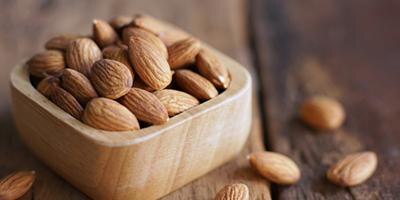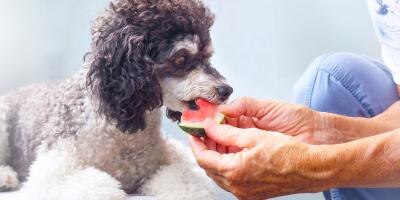
If you're wondering "How much food should I feed my dog?" you're not alone. How much to feed your dog and what food to choose are common questions from dog owners, and it's important to have an understanding of how to feed your dog for their best health. Learn more about best practices and tips in this dog feeding guide.
What to Consider When Deciding How Much to Feed Your Dog
Almost all dog foods have feeding recommendations on the outside of the bag, and most go by weight. However, other factors such as breed and activity level may warrant some adjustments.
Breed and Weight
In general, larger breeds need more food and smaller breeds need less food, but it's important to consider your dog as an individual as well. Keeping your dog at a healthy weight is one of the most important things you can do for his overall health. If your dog is already on the chubby side, you may want to consider feeding a bit less than the recommended amounts, especially if your dog is one that will eat whatever amount you put down regardless if he is full. Dogs who are underweight may need more food, but it's important to talk to a vet about this, as sometimes a higher calorie food may be a better choice than just upping the volume.
Activity Level
Working dogs or those that are very active may need more food than the average house pet. On the other end of the spectrum, dogs that don't get regular exercise may not need as much food to stay at a healthy weight.
Age
Whether your dog is a puppy, adult or senior, this can factor in to how much food — and what kind — they need. Talk to your veterinarian about how these life stages impact your dog's dietary needs and to get recommendations on how to best meet them.
Choosing a Dog Food
When it comes to choosing a dog food, you'll want to consider the type, the nutrition content and any specific dietary needs your dog has.
Wet or Dry
Whether you decide to serve food wet or dry is really a matter of personal preference — both yours and your dog's. Dry food may be more readily available and more convenient to use, but it's not a bad idea to get your dog familiar with both in case you ever need to change their food. Wet food may be needed for senior dogs or those with dental issues who can no longer chew up kibble.
Breed-Specific Options
While it may seem counter-intuitive, smaller breeds actually have faster metabolisms than larger dogs and may need more calories. Look for breed-specific foods that are formulated to provide more targeted nutrition. Breed-specific foods may also have different sized kibbles to make it easier for dogs with smaller mouths to chew or to help slow down larger dogs who may be more prone to gulping. There are also some formulas made specifically for working dogs who are more active and need higher levels of fat, protein and vitamins such as B12 to help release the energy from food. These may also include vitamin E to help their muscles recover more effectively.
Special Health Considerations
If your dog has any special health issues, like skin or stomach sensitivities, ask your vet about specialist adult dog foods. Foods made with alternative protein sources, such as salmon and duck, may be less likely to cause flareups. Dogs with medical issues such as diabetes may also need specialty foods.
How to Feed Your Dog
Once you've decided on the right food and how much to feed your dog, you'll need to establish a feeding routine and know what to avoid. Here are some best practices to get you started.
Find the Right Place
Carve out some space for your dog's feeding location. Make sure it's quiet and away from the noise and activity of the house. Always ensure the bowl is clean, and slip a mat underneath if it tends to slide across the floor. If you have more than one dog, it may be best to feed them separately to avoid any arguments over food.
Decide How Often
The general recommendation is to feed your dog once or twice a day. Smaller dogs often do well with more frequent feedings of a lesser volume, and feeding smaller amounts more frequently can also help large dogs who bolt their food, which can cause serious health issues in some cases.
Consider Your Specific Dog
Older dogs who have trouble bending, or those with certain health issues, may benefit from raised dog feeders, but make sure to check with your vet first. You may also want to consider a special bowl that makes it harder for your dog to eat a lot of food at once by spreading it out or creating ridges in the bowl so they have to take smaller bites.
Avoid Certain Foods
It's important to remember that dogs are not humans, and many human foods are bad for their health despite how yummy they may seem to your pet. Here are a few of the foods to avoid giving your dog, but you should also check with your veterinarian before giving them anything other than dog food and the occasional dog treat.
- Raw meat. Meat should be cooked to kill bacteria that can cause food poisoning and should be unseasoned.
- Bones. Brittle chicken and fish bones can damage teeth and cause obstructions in the gut. Although larger bones are often given to dogs, they can also cause obstructions to the gut as they splinter, so avoid giving them to your pet.
- Chocolate. This is poisonous to dogs and should be avoided at all costs.
- Onions, grapes and raisins. These are all highly toxic to dogs.
Use Treats Appropriately
Your dog probably loves treats, but over-feeding them can be detrimental to your dog's health. If you're planning on giving your dog treats, make sure to account for those extra calories by cutting down their regular food. You may also want to reserve treats for training to give your dog an extra incentive. As a general rule, limit treats, biscuits and chews to no more than 15% of your dog's daily intake, or 10% if you feed smaller, meat-based rewards. Functional treats like chews or low-calorie offerings like raw carrots may also be able to be used, but always check with your vet first if you aren't sure or are considering adding a new treat to your dog's diet.
Related articles



